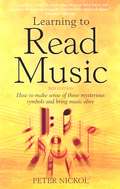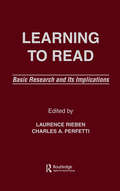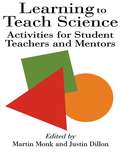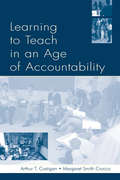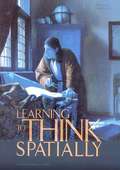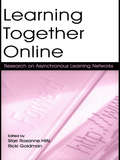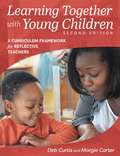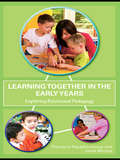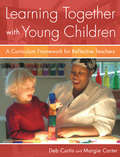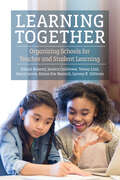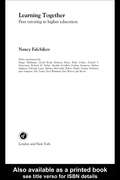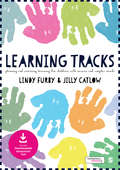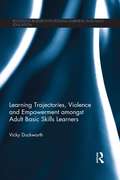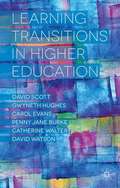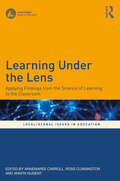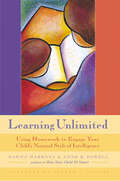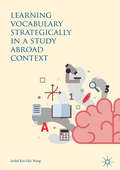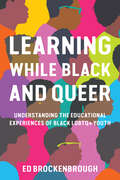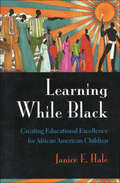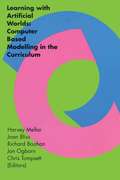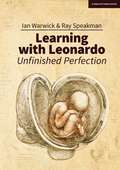- Table View
- List View
Learning To Read Music 3rd Edition: How To Make Sense Of Those Mysterious Symbols And Bring Music Alive
by Peter NickolWhether you want to learn how to play an instrument, or just refresh your existing capability, whether you sing in a choir, or would simply like to follow scores while listening, this book will help you achieve your aim. It leads you carefully through the basics of pitch, rhythm, keys, scales, chords, and much more, building your knowledge chapter by chapter until you are able to read music with ease. The visual index of musical symbols laid out at the start will make clear the task at hand.Reference to common instruments and familiar tunes will help bring your learning to life, while self-testing and chapter summaries ensure that you develop and retain this new skill. By the end of the book, you will have come a long way. Your knowledge of music notation will be a pleasure to you, and a useful tool. As well as its practical applications for any performer, this book will give you insights into how music is put together. You will have the feeling of knowing the music from the inside out.
Learning To Read Music 3rd Edition: How to make sense of those mysterious symbols and bring music alive
by Peter NickolWhether you want to learn how to play an instrument, or just refresh your existing capability, whether you sing in a choir, or would simply like to follow scores while listening, this book will help you achieve your aim. It leads you carefully through the basics of pitch, rhythm, keys, scales, chords, and much more, building your knowledge chapter by chapter until you are able to read music with ease. The visual index of musical symbols laid out at the start will make clear the task at hand.Reference to common instruments and familiar tunes will help bring your learning to life, while self-testing and chapter summaries ensure that you develop and retain this new skill. By the end of the book, you will have come a long way. Your knowledge of music notation will be a pleasure to you, and a useful tool. As well as its practical applications for any performer, this book will give you insights into how music is put together. You will have the feeling of knowing the music from the inside out.
Learning To Read: Basic Research and Its Implications
by Charles A. Perfetti Laurence RiebenHow does a young child begin to make sense out of squiggles on a page? Is learning to read a process of extending already acquired language abilities to print? What comprises this extension? How children learn to read, and especially how children are taught to read, are problems of sustained scientific interest and enduring pedagogical controversy. This volume presents conceptual and theoretical analyses of learning to read, research on the very beginning processes of learning to read, as well as research on phonological abilities and on children who have problems learning to read. In so doing, it reflects the important discovery that learning to read requires mastering the system by which print encodes the language. The editors hope that some of the work offered in this text will influence future research questions and will make a difference in the way instructional issues are formulated.
Learning To Teach Science: Activities For Student Teachers And Mentors
by Justin Dillon Martin MonkIn response to requests by science teachers for guidance on the process of mentoring in schools, this text provides an interactive, activities-based resource. It takes into account the progressive development of skills and competencies, for all those involved in the training of science teachers; pre-service, in-service and quality control. Activities are directly related to classroom and laboratory planning, organisation and management and include general question and answer exercises.; The book covers nine areas of science teacher competence crossed with five levels of progression to give a flexible programme of training. Each activity has a commentary for mentors and notes for student teachers, and discusses the rationale behind each activity. Five activities are written specifically to help mentors review progress at each of the five levels.; Additionally, it can be used by: experienced teachers for refreshing their own practice; Heads of Science Departments for upgrading science teaching within the departments; and those concerned with quality control and certification to recommend activities, taken from the book, to aid further professional development.
Learning To Teach in an Age of Accountability
by Arthur T. Costigan Karen Kepler Zumwalt Margaret Smith CroccoThis book documents the "brave new world" of teacher, administrator, school, and student accountability that has swept across the United States in recent years. Its particular vantage point is the perspective of dozens of new teachers trying to make their way through their first months and years working in schools in the New York City metropolitan area. The issues they grapple with are not, however, unique to this context, but common problems found today in urban, suburban, and rural schools across the United States. The stories in this book offer a compelling portrait of these teachers' encounters with the new culture of accountability and the strategies they develop for coping, even succeeding, within such demanding settings. Learning to Teach in an Age of Accountability: *introduces research on teaching and engages the "big ideas" concerning teacher research, highlighting what we know and where that leads us; *offers a rich set of teacher narratives that are organized to widen the angle of vision from biography, to classrooms, schools, and society; and *includes questions and activities to encourage discussion and further research about the ideas raised; and *addresses the possibilities for best practice and curricular decision making in light of the issues and ideas presented in the book. This volume--unique in its portrayal of new teachers' encounters with issues of accountability--makes a singular contribution to the educational literature on new teachers. It is relevant to everyone interested in the contemporary world of teaching, and is particularly appropriate as a text for preservice and in-service students. All readers who believe that the key to a good school lies in attracting and keeping good teachers will find the issues presented here both personally engaging and deeply troubling.
Learning To Think Spatially
by National Research Council of the National AcademiesSpatial thinking—a constructive combination of concepts of space, tools of representation, and processes of reasoning—uses space to structure problems, find answers, and express solutions. It is powerful and pervasive in science, the workplace, and everyday life. By visualizing relationships within spatial structures, we can perceive, remember, and analyze the static and dynamic properties of objects and the relationships between objects. Despite its crucial role underpinning the National Standards for Science and Mathematics, spatial thinking is currently not systematically incorporated into the K-12 curriculum. Learning to Think Spatially: GIS as a Support System in the K-12 Curriculum examines how spatial thinking might be incorporated into existing standards-based instruction across the school curriculum. Spatial thinking must be recognized as a fundamental part of K-12 education and as an integrator and a facilitator for problem solving across the curriculum. With advances in computing technologies and the increasing availability of geospatial data, spatial thinking will play a significant role in the information- based economy of the 21st-century. Using appropriately designed support systems tailored to the K-12 context, spatial thinking can be taught formally to all students. A geographic information system (GIS) offers one example of a high-technology support system that can enable students and teachers to practice and apply spatial thinking in many areas of the curriculum.
Learning Together Online: Research on Asynchronous Learning Networks
by Starr Roxanne Hiltz Ricki GoldmanThis book is about the past and future of research on the effectiveness of learning networks (also known as "e-learning" or "online learning" or "Web-based learning"). Learning networks are groups of people using computer technology, communicating and collaborating online to build knowledge together. Over the past decade there has been an explosion not only of online courses, but also of studies on them. In Learning Together Online: Research on Asynchronous Learning Networks, leading researchers in the field use an integrated theoretical framework, which they call "Online Interaction Learning Theory," to organize what past research shows and where future research is going. It models the variables and processes that are important in determining the relative effectiveness of online learners working to reach a deeper level of understanding by interacting with each other and with the texts under investigation. Now that there have been hundreds of studies and thousands of courses offered online, what does the empirical evidence show? This book addresses the question directly by presenting what is known from research results about how to design and teach courses effectively online, ranging from the organizational context and characteristics of students to learning theories and research design methods. It also provides a research agenda for the next decade. Learning Together Online: Research on Asynchronous Learning Networks is both a textbook for graduate students and a professional reference for faculty teaching online, researchers conducting studies, and graduate students taking courses about learning technologies who need to know the state of the art of research in the area of online learning.
Learning Together With Young Children: A Curriculum Framework For Reflective Teachers
by Deb Curtis Margie CarterMany curriculum books treat teaching as something teachers do to or for children. Deb Curtis and Margie Carter, best-selling authors in the early learning field, believe teaching is a collaborative process in which teachers reexamine their own philosophies and practices while facilitating children’s learning. Each chapter in this curriculum framework includes a conceptual overview followed by classroom stories and photographs to illustrate the concepts. The book helps teachers create materials and a classroom culture reflective of their values: Teach through observation, reflection, inquiry, and action, and encourage children to represent their learning in multiple ways, including songs, stories, and drama.
Learning Together in the Early Years: Exploring Relational Pedagogy
by Janet Moyles Theodora PapatheodorouRelational pedagogy underpins the core principles of both the cognitive, and social/emotional development of young children, as evidenced in the Reggio Emilia preschools and the Te Whariki curriculum in New Zealand. Emphasising the links between, people, places and ideas and the effects of these on education, educators and learners, it is integral to the English Early Years Foundation Stage, and forms the basis for early years provision around the world. This book brings together contributions from international experts on early years education to explore and debate relational pedagogy across different countries and in the context of a broad international field. The three sections of the book cover the following areas: culture, environment and adult child relationships - how children and adults relate to the culture, ethos and environment in which they function; adult-child relationships - how education and care environments directly relate to learning and teaching; adult-adult relationships for professional development - in training situations and parental partnerships. The book will be of interest to all those who want to delve deeper into how these interactions affect teaching and learning and to understand how the context can have its own impact on pedagogical outcomes. Researchers in early years education and students on early childhood education courses will find much here to inspire and challenge their thinking.
Learning Together with Young Children
by Deb Curtis Margie CarterMany curriculum books treat teaching as something teachers do to or for children. Deb Curtis and Margie Carter, best-selling authors in the early learning field, believe teaching is a collaborative process in which teachers reexamine their own philosophies and practices while facilitating children's learning.Each chapter in this curriculum framework includes a conceptual overview followed by classroom stories and photographs to illustrate the concepts.The book helps teachers create materials and a classroom culture reflective of their values: Teach through observation, reflection, inquiry, and action, and encourage children to represent their learning in multiple ways, including songs, stories, and drama.
Learning Together: Organizing Schools for Teacher and Student Learning
by Elham Kazemi Jessica Calabrese Teresa Lind Becca Lewis Alison Fox Resnick Lynsey K. GibbonsA blueprint for structuring the school environment around teacher learning and collaboration as a foundation for equitable learning and student engagement
Learning Together: Peer Tutoring in Higher Education
by Nancy FalchikovThe number of students in higher education has expanded dramatically in recent years, but funding has not kept pace with this growth. The result is less contact time for lecturers and their students, and corresponding worries about how the quality of teaching and learning can be improved. Peer tutoring is one method which is growing in popularity, and has already proved successful in a number of countries. This book provides an introduction to the methods and practice of peer tutoring focusing on how to set up schemes and how to cope with common problems. It discusses the theory behind this form of learning and the beneficial effects associated with it. Summaries are included at the end of each chapter.
Learning Tracks: Planning and Assessing Learning for Children with Severe and Complex Needs
by Jilly Catlow Lindy FurbyLearning Tracks is a planning and tracking resource to support the planning and assessment of learning for children and young people with severe and complex learning disabilities. It was designed by the authors whilst teaching at a school for children and young people with severe and complex learning disabilities. This easy to use method is ready to implement in any setting to help assess children at the lowest levels of learning. It gives you, in a snapshot, where to focus your efforts with a class, a group or an individual child in order to help them progress in a meaningful way. At the very early stages of learning the steps that children and young people make can be small but incredibly significant for them and those that teach them. However, it can be problematic to evidence and formally recognise these achievements and plan next steps. Learning Tracks presents a framework to recognise achievement at these early levels and plan for progression through challenge, breadth and application. The Learning Tracks framework for recognising achievement at very early levels of learning: Can help teachers understand the way their children may be learning Offers a vocabulary for describing the learning Offers a structure for planning the learning
Learning Tracks: Planning and Assessing Learning for Children with Severe and Complex Needs
by Jilly Catlow Lindy FurbyLearning Tracks is an assessment tool to support the planning and assessment of learning for children and young people with severe and complex learning disabilities (SCLD). It was designed by Lindy Furby and Jilly Catlow while teaching at St Crispin’s School for children and young people with severe and complex learning disabilities. At the very early stages of learning, the steps that children and young people make can be small but incredibly significant for them and those who teach them. However, it can be problematic to evidence and formally recognise these achievements and plan next steps. Learning Tracks presents a framework to recognise achievement at these early levels and plan for progression through challenge, breadth and application. The Learning Tracks framework for recognising achievement at very early levels of learning: Can help teachers understand the way their children may be learning Offers a vocabulary for describing the learning Offers a structure for planning the learning When you purchase Learning Tracks, you receive the book that introduces you to the framework and theories underpinning Learning Tracks, describes the curriculum included and demonstrates how it can be implemented in your setting. In addition to this book you will also receive access to the complete ready-made Learning Tracks assessment tool that can be downloaded online. This is available as a PDF with editable elements and a template you can personalise it to suit your individual needs.
Learning Trajectories, Innovation and Identity for Professional Development
by Anne Mc Kee Michael ErautEducators in the professions have always had unique demands placed upon them. These include the need to keep pace with rapidly evolving knowledge bases, developing skills and attitudes appropriate to practice, learning in the workplace and fostering public confidence. For twenty years, these new demands have created additional educational imperatives. Public accountability has become more intensive and extensive. Practitioners practice in climates more subject to scrutiny and less forgiving of error. The contexts in which professionals practice and learn have changed and these changes involve global issues and problems. Often, professionals are the first responders who are required to take an active stance in defining and solving problems. This book explores the pedagogic implications of these challenges internationally for a wide range of professions which include: accountants, military company commanders, surgeons, nurse practitioners, academic, managers, community physicians and dentists. The established view of professional development is about what the professional knows and can do. The authors broaden this view to include the systemic and contextual factors that affect learning, and the conditions necessary for effective practice and identity development across the professional lifespan. Authors examine the unique particularities and requirements of diverse professional groups. The editors emphasize new ideas and learning that emerges across the professions. As readers use this book as a pathway to their own innovations in scholarship and pedagogic research, they join their colleagues in supportingnew directions in learning, teaching and assessment across professions.
Learning Trajectories, Violence and Empowerment amongst Adult Basic Skills Learners (Routledge Research in Lifelong Learning and Adult Education)
by Vicky DuckworthLearning Trajectories, Violence and Empowerment amongst Adult Basic Skills Learners offers deep insights into the lives of marginalised communities and the link between learning, literacy and violence, not previously carried out in-depth in a small scale study. It breaks the negative stereo-types of adults who struggle to read and write, who are often labelled and stigmatised by dominant discourses, and in doing so exposes why and how Basic Skills Learners often find themselves in marginal positions. The structural inequalities many face from childhood to adulthood across the private and public domains of their lives are revealed and probed, thus challenging neo-liberalism claims of an apparently egalitarian social field. The learners’ narratives expose the contradiction, complexities and ambivalences they experience in their daily lives, and how they try to make sense of them from their structural positioning as basic skills learners in a society based on inequality of opportunity and choice. Applying a feminist, qualitative, longitudinal, ethnographic and participatory approach, the book offers a critical perspective, drawing on Bourdieu’s work as the theoretical framework, as well as using a range of feminist, sociologists of education, literature on the ethics of care and critical literacy pedagogy, including the New Literacy Studies. The author’s personal position as an ’insider’ with ‘insider knowledge’ of marginalised communities is also woven throughout the chapters and offers insights into the struggles, conformity and resistance faced by the participants in the study. The book contributes to the debate on the impact of violence on learning and its link to class, gender and basic skills as well opening up a discussion on the power of a critical curriculum to empower people across the domains of their lives. It will be valuable reading for trainee teachers, teachers, education and sociology students, postgraduate students, as well as literacy specialists, researchers, academics, policy makers and managers of public services.
Learning Transitions in Higher Education
by David Scott David Watson Carol Evans Gwyneth Hughes Penny Jane Burke Catherine WalterThis book draws on a study of student transitions in higher education institutions to both unpack the concept of a learning transition and develop pedagogic strategies to enable learners to develop their learning careers. This book provides an original perspective on teaching and learning in higher education.
Learning Under the Lens: Applying Findings from the Science of Learning to the Classroom (Local/Global Issues in Education)
by Annemaree Carroll Annita Nugent Cunnington RossLearning Under the Lens: Applying Findings from the Science of Learning to the Classroom highlights the innovative approach being undertaken by researchers from the disparate fields of neuroscience, education and psychology working together to gain a better understanding of how we learn, and its potential to impact student learning outcomes. The book is structured in four parts: ‘Science of learning: a policy perspective’ sets the scene for this emerging field of research; ‘Self regulation of learning’ and ‘Technology and learning’ feature findings by eminent international and national researchers in the field and provides an insight into some of the innovative research illustrating the depth, breadth and multi-disciplinarity of the research; and ‘Research translation’ focuses on the scaled-up implementation of research findings in authentic learning settings, and showcases research findings which are having impact in learning environments. This fascinating book is intended as a reference tool to create awareness among researchers, policy makers, and education practitioners of the research being undertaken in the science of learning field and its potential to impact student learning outcomes.
Learning Unlimited: Using Homework to Engage Your Child's Natural Style of Intelligence
by Dawna Markova Anne R. PowellFrom the authors of How Your Child is Smart, a guide to creating a natural learning environment for a child at home.Natural learning starts at home. Anyone who spends time with young children recognizes their natural intelligence and resilient passion to learn. But as they try to meet the pressures and expectations of school, natural learning diminishes. Does it have to be that way? According to teachers Dawna Markova and Anne R. Powell, absolutely not. Whether a parent or educator, Learning Unlimited helps transform the homework hassle from a nightly struggle to an engaged learning initiative that uncovers the unique gifts of your child’s mind.Learning from your child’s natural motivation. Filled with practical advice and compassionate support, this book is designed to honor your child’s innate intelligence with family engaged learning strategies. In Learning Unlimited, veteran teachers unveil how learning from homework can also function as a joint inquiry into your child’s special gifts. Designed for optimal parental involvement in education, this guide helps parents give children a competitive advantage by cultivating a life-long love of learning.Praise for Learning Unlimited“Markova and Powell . . . are proponents of the teaching movement that uses visual, audio and kinesthetic presentations to educate. Proposing that each child has his or her own personal operating system (POS) to receive, integrate and express learning, the authors suggest ways by which related classroom tactics can be applied to homework . . . . This primer is brimming with fun, unusual and practical ideas likely to benefit parents, students and educators.” —Publishers Weekly
Learning Vocabulary Strategically in a Study Abroad Context
by Isobel Kai-Hui WangThis book focuses on case studies of vocabulary strategy use and presents an in-depth account of the vocabulary learning experiences of Chinese students in the UK. It challenges the view that vocabulary strategies result only from learners' cognitive choices, and provides insightful analysis of the interplay between learner characteristics, agency and context in the process of strategic learning. The author makes a strong case for using qualitative methodologies to examine the dynamic, complex and contextually situated nature of strategic vocabulary learning. Drawing on multiple data sources, the book discusses issues that are central to the continuing development of vocabulary strategy research and offers theoretical, research-based and practical suggestions for future exploration. This book will appeal to students and scholars of second language acquisition, vocabulary and applied linguistics.
Learning WalkThrus: Students & Parents - better learning, step by step
by Tom SherringtonLEARNING WALKTHRUs is a visual guide to key aspects of learning and studying at home and at school. It features 70+ five-step techniques devised by Tom Sherrington and illustrated by Oliver Caviglioli, with guest authors including Sarah Cottingham, Peps Mccrea, Sara Milne Rowe, Christopher Such, Emma Turner and Jennifer Webb. Students: this book is for you. It's a guide to how we learn and how to study effectively, to help you make the most of your time at school.Parents: this book is also for you. We hope it will support you in the vital role you play in your children's education.Sections include: How we learn; In the classroom; Feedback & improvement; Study habits & techniques; Reading & writing; Independent learning; Learning in subjects.Tom and Oliver are the creators of the internationally successful Teaching WalkThrus series, comprising three volumes of five-step instructional coaching techniques and a range of online resources. For more information visit www.walkthrus.co.uk
Learning While Black and Queer: Understanding the Educational Experiences of Black LGBTQ+ Youth
by Ed BrockenbroughResearch-based guidance for educators, teacher educators, and community learning partners to effectively support LGBTQ+ students of color
Learning While Black: Creating Educational Excellence for African American Children
by Janice E. HaleIn Learning While Black Janice Hale argues that educators must look beyond the cliches of urban poverty and teacher training to explain the failures of public education with regard to black students. Why, Hale asks simply, are black students not being educated as well as white students? Hale goes beyond finger pointing to search for solutions. Closing the achievement gap of African American children, she writes, does not involve better teacher training or more parental involvement. The solution lies in the classroom, in the nature of the interaction between the teacher and the child. And the key, she argues, is the instructional vision and leadership provided by principals. To meet the needs of diverse learners, the school must become the heart and soul of a broad effort, the coordinator of tutoring and support services provided by churches, service clubs, fraternal organizations, parents, and concerned citizens. Calling for the creation of the "beloved community" envisioned by Dr. Martin Luther King, Jr., Hale outlines strategies for redefining the school as the Family, and the broader community as the Village, in which each child is too precious to be left behind. "In this book, I am calling for the school to improve traditional instructional practices and create culturally salient instruction that connects African American children to academic achievement. The instruction should be so delightful that the children love coming to school and find learning to be fun and exciting."—Janice Hale
Learning With Artificial Worlds: Computer Based Modelling In The Curriculum
by Richard Boohan Jon Ogborn Harvey Mellar Joan Bliss Chris TompsettFirst Published in 1994. Routledge is an imprint of Taylor & Francis, an informa company.
Learning With Leonardo: Unfinished Perfection: Making children cleverer: what does Da Vinci tell us?
by Ian Warwick Ray SpeakmanWhat are the seven key concepts that drove Da Vinci's inventive thinking and how can we still use them to improve our own creativity, 500 years after his death? In pursuit of the unified learning principles that sit at the heart of his work, Ian Warwick and Ray Speakman brilliantly explore the approaches that we need to take to make our own learning more original and thoughtful.
